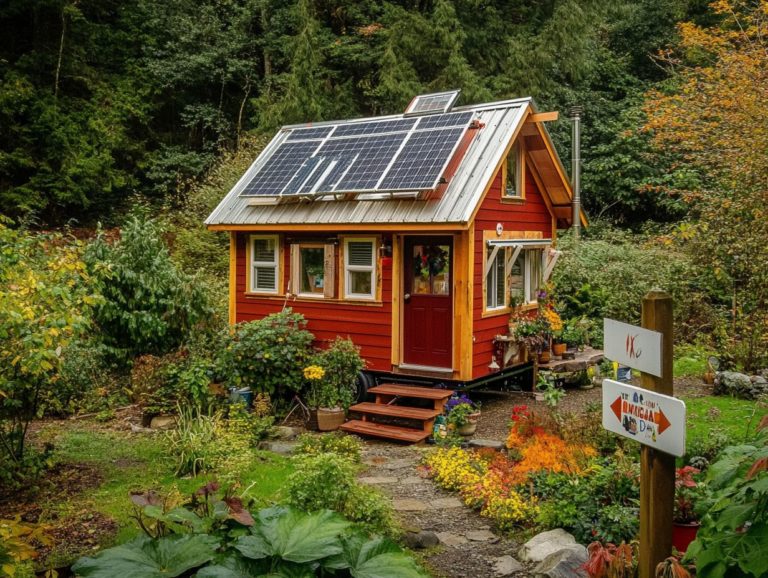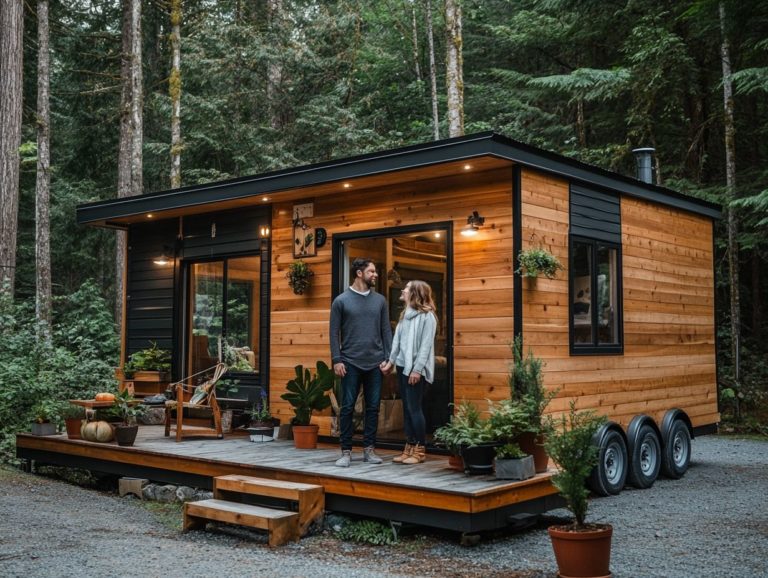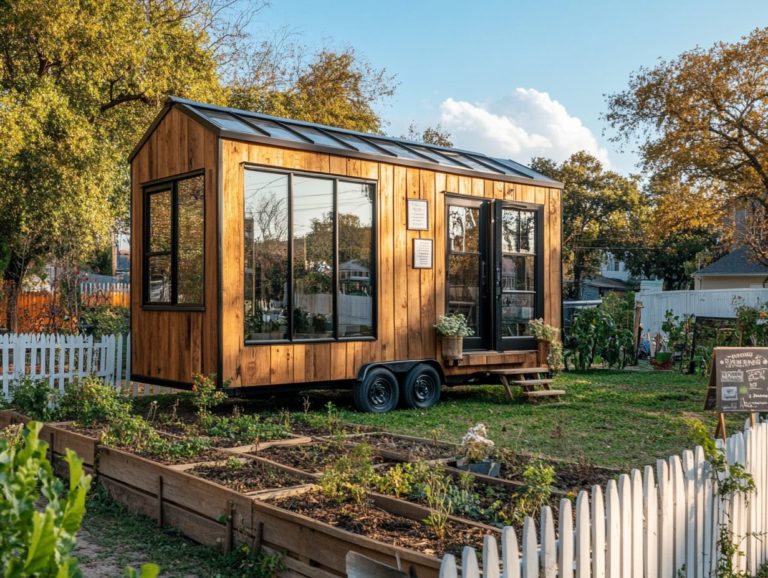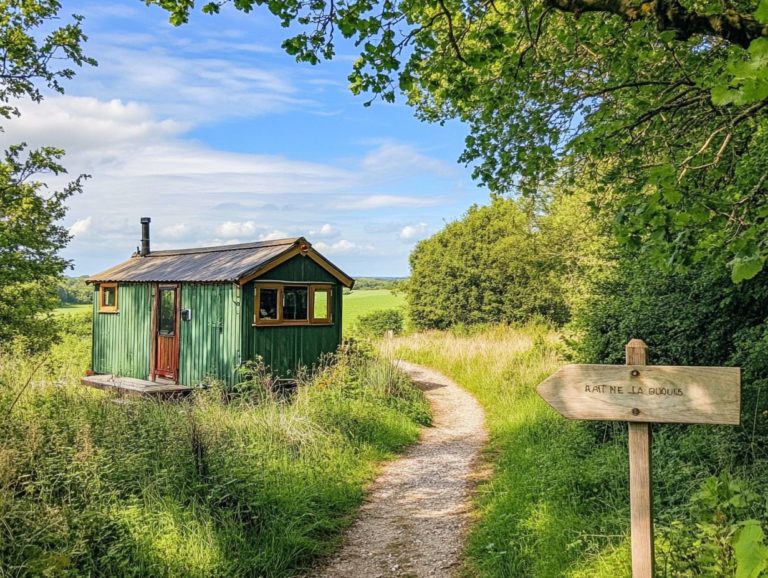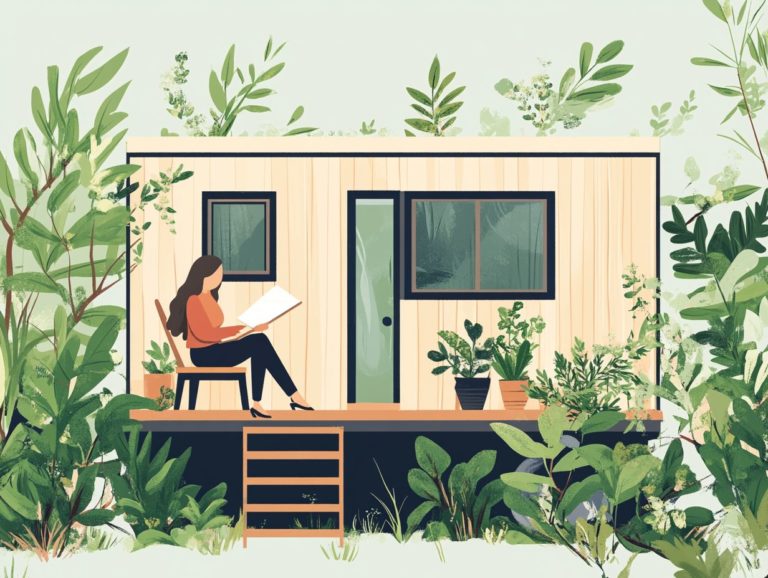Dealing with Tiny House Legal Issues
Tiny houses have captivated your imagination, presenting a delightful blend of simplicity and sustainability. Navigating the legal landscape can be tricky, but you can conquer it with the right information.
As an aspiring tiny house owner, it’s crucial to stay informed about zoning laws and building codes. You ll face common legal hurdles, so understanding these regulations is imperative.
This article will guide you through the essentials of tiny house regulations, explore alternative living arrangements, and offer insights into managing the legal challenges you may encounter.
Get ready to explore the exciting world of tiny house living and what you need to know!
Contents
Key Takeaways:

- Always research and understand the current laws and regulations regarding tiny houses before building or purchasing one.
- Be aware of common legal issues that may arise for tiny house owners, and have a plan in place for handling them.
- Consider alternative living options for tiny house enthusiasts, such as RV parks or community land trusts, to potentially avoid legal challenges.
Understanding the Legalities of Tiny Houses
The Tiny House Movement has truly taken off in recent years, presenting you with an innovative solution to the intricacies of modern housing through minimalist living and a focus on sustainability.
Tiny houses, whether perched on wheels or firmly planted on a foundation, come with their own unique legal challenges. These challenges primarily stem from the varying laws and regulations, including understanding tiny house zoning laws, that differ from state to state.
For anyone considering ownership, grasping the legal landscape surrounding tiny homes is crucial. Understanding zoning regulations, the rules about where and how you can place your tiny house, and building codes can feel overwhelming. To navigate these complexities, referring to tiny house regulations: a state-by-state guide can be particularly helpful, especially for those eager to join the vibrant tiny house communities emerging across the country.
What is a Tiny House?
A tiny house is a compact haven, usually measuring between 100 to 400 square feet, designed to maximize functionality while minimizing environmental impact. It s a perfect embodiment of the Tiny House Movement.
These charming dwellings often showcase innovative storage solutions, multifunctional furniture, and clever use of natural light. This combination creates an inviting atmosphere. Living in such limited spaces fosters a sense of community and encourages you to embrace minimalism, shedding the excess that can weigh you down.
The movement champions sustainability. Many tiny houses are constructed from recycled or eco-friendly materials, significantly reducing their carbon footprint. As you revel in these benefits, be prepared to tackle challenges like strict zoning laws and the need for creative problem-solving within smaller layouts.
After all, every square inch counts in your pursuit of financial freedom.
Current Laws and Regulations
Current laws and regulations regarding tiny homes can vary significantly from one jurisdiction to another. It s essential for you, as a tiny house owner, to understand the specific requirements that apply to your location.
Local zoning departments often define whether you can position your tiny home on private property or if it s permitted only within designated communities. For example, in Georgia, some counties allow tiny houses on wheels as temporary dwellings but impose strict regulations for permanent structures. In contrast, Colorado has adopted more lenient standards, permitting tiny homes to function as accessory dwelling units if they meet specific building codes.
On the other hand, Connecticut is known for its more restrictive policies, where tiny homes may not be recognized as legal residences unless they adhere to traditional housing regulations. Thus, conducting thorough research into the laws of your state is essential to avoid potential legal complications and fully embrace your new lifestyle.
Start your research today and take the first step toward your tiny house dream!
Zoning and Building Codes for Tiny Houses

Zoning and building codes are essential in determining the legality and feasibility of your tiny house project. Whether it s a charming tiny house on wheels or one anchored on a foundation, these regulations dictate the minimum square footage you must meet. They also specify the necessary permits to secure.
Understanding these codes is vital for ensuring your dream home is not only beautiful but also compliant with local laws.
Local Zoning Laws
Local zoning laws play an important role in shaping the landscape of tiny house communities, particularly in Hawaii and Idaho. They determine where these charming homes can be situated and the criteria they must fulfill.
For you as a tiny house owner, navigating tiny house community regulations is essential. These laws can directly influence the practicality and appeal of living in such distinctive dwellings. Understanding local zoning laws could be the key to successfully joining a community! Avoid potential legal hurdles by staying informed.
In some regions, zoning regulations have evolved to encourage tiny house developments. These designated areas allow these homes to thrive often championing sustainability and affordability. However, stricter zoning laws may impose minimum square footage requirements or limit where tiny homes can be installed, leaving you with fewer choices.
Local zoning departments are essential in this journey. They manage compliance, assess community needs, and balance development with the concerns of existing residents. Their guidance is invaluable for anyone looking to join or establish tiny house communities.
Building Codes for Tiny Houses
Building codes are vital for ensuring the safety and livability of tiny houses. These often align with the International Building Code or the International Residential Code, which outline specific standards and plumbing requirements.
The type of tiny home you choose also affects these regulations. Whether it’s on wheels or a permanent foundation, each category has its own unique requirements to fulfill. For example, plumbing systems must adhere to certain standards to prevent contamination and guarantee proper waste disposal essential for safeguarding your health.
Safety standards cover aspects like fire safety measures, structural integrity, and ventilation systems. These ensure that your compact living space remains both secure and comfortable.
Therefore, it s crucial for you, as an aspiring tiny house owner, to thoroughly review the relevant codes and guidelines to create a safe and legal home.
Navigating Legal Challenges for Tiny House Owners
Navigating the intricate legal landscape can pose a considerable challenge for tiny house owners. You must grapple with a myriad of tiny house laws, zoning regulations, and building codes that can differ significantly from one locale to another.
Each jurisdiction brings its own set of complexities, requiring careful attention and understanding to ensure compliance and to successfully establish your tiny home.
Common Legal Issues and How to Handle Them
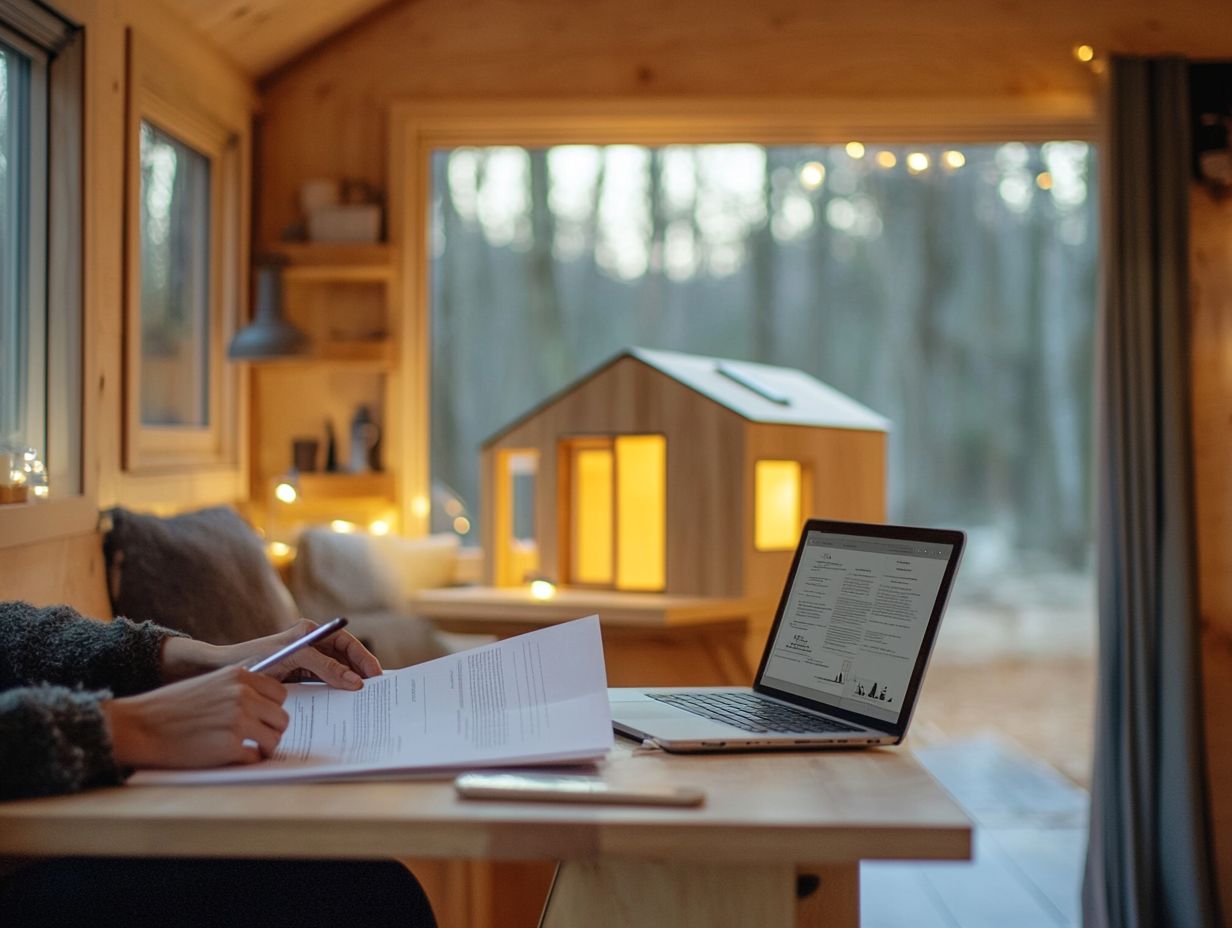
Common legal issues you might encounter as a tiny house owner can vary from improper zoning to disputes with neighborhood associations. It s essential for you to grasp tiny house laws to effectively navigate these challenges.
Many of these problems arise from ambiguity surrounding what actually qualifies as a tiny house. This can potentially lead to misunderstandings with local regulations. Zoning disputes often occur when a tiny house is placed in an area intended for larger dwellings or incompatible land uses.
Securing building permits can become particularly cumbersome if your tiny house doesn t align with local codes. This could result in fines or even eviction.
To successfully navigate these complexities, you should begin by researching local zoning laws and actively engaging with local authorities. Building a rapport with your neighbors can also be advantageous; open communication may ease concerns and foster support for tiny house communities.
If conflicts do arise, seeking legal advice or mediation can prove beneficial.
Alternative Living Options for Tiny House Enthusiasts
For those passionate about the Tiny House Movement, exploring alternative living options opens a promising avenue toward homeownership. This journey requires understanding the intricate landscape of zoning and building codes, which may include looking into accessory dwelling units or engaging with tiny house communities.
Embracing these innovative solutions can make the dream of a simpler, more sustainable lifestyle a tangible reality.
Options for Living in a Tiny House Legally
Living in a tiny house legally means navigating specific zoning regulations and building codes. You’ll find options like extra living spaces and tiny house communities that pave the way for this lifestyle.
These frameworks present innovative alternatives to traditional housing. They enable you to embrace a minimalist lifestyle while staying compliant with local laws.
Extra living spaces can be secondary residences on existing properties, maximizing space and enhancing community density. Tiny house communities often cultivate a sense of belonging and shared values, promoting sustainability and resource efficiency among residents.
Challenges like securing financing, navigating restrictive regulations, and overcoming community resistance may arise. It’s crucial for anyone considering this path to thoroughly research and understand their chosen approach, including the legalities of tiny house communities, to ensure a smooth transition into tiny living.
Pros and Cons of Different Living Arrangements
As a tiny house enthusiast, you might find yourself weighing the merits of tiny house communities against extra living spaces (ADUs). Each option presents its own unique set of advantages and challenges.
On one hand, tiny house communities offer a nurturing environment. They foster connections with like-minded individuals who share your passion for minimalism and sustainable living.
These communal spaces often promote social interactions, cultivating a deep sense of belonging.
On the flip side, extra living spaces, typically found on a homeowner s property, provide a greater degree of privacy and flexibility. You might miss out on community support with this arrangement.
Legal compliance can also differ dramatically. Tiny house communities often have regulations encouraging eco-friendly living, while ADUs must navigate city codes that can feel rather complicated.
Ultimately, your decision will hinge on your personal preferences regarding social dynamics, regulatory challenges, and the overall impact on your lifestyle.
Check out this video to learn more about tiny house living!
Frequently Asked Questions
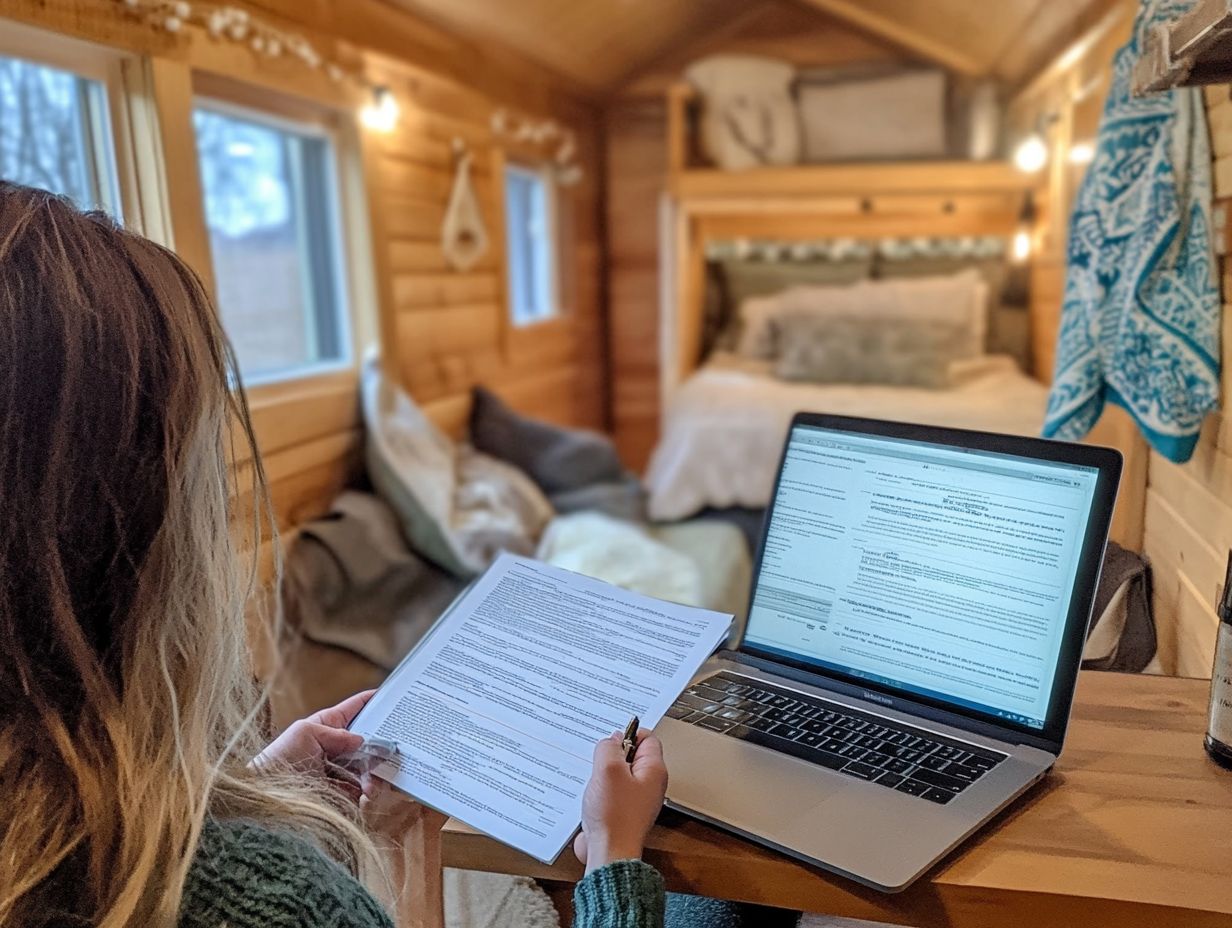
What are the common legal issues associated with tiny houses?
Some common legal issues include zoning and building code regulations, property tax assessments, and finding a suitable location to park the tiny house.
Do I need a permit to build a tiny house?
It all boils down to the rules in your area. Generally, if the tiny house is on wheels and considered an RV, you may not need a permit. However, if it s viewed as a permanent structure, you will likely need one.
Can I park my tiny house anywhere I want?
No, you cannot park your tiny house just anywhere. Most areas have zoning laws that regulate where you can live in a tiny house. You may need to find a designated tiny house community or apply for a special permit.
Can I live in a tiny house full-time?
This again depends on your local regulations. Some areas only allow tiny houses to be used as secondary dwellings, while others permit them as permanent residences. It’s important to research and comply with the laws in your area.
Do I have to pay property taxes on my tiny house?
Yes, you may still be subject to property taxes on your tiny house, depending on how it is classified and where it is located. It’s important to research and understand the tax laws in your area.
Are there any legal protections for tiny house owners?
Some states have laws that specifically address tiny houses, allowing them in certain areas or exempting them from certain regulations. However, these laws are still relatively new and may not be available in all areas.

